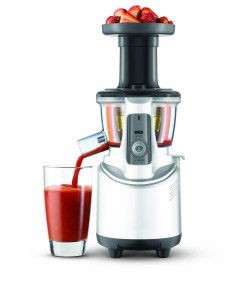Guest Writer for Wake Up World
Juicing can be an intimidating practice, even for the most seasoned natural health enthusiast. It not only takes time and effort, but an ambitious pallet to experiment with different flavor profiles among fruits and vegetables.
Lucky for me, my office is right next door to a new (and incredible) juice bar called Puree. Puree offers freshly pressed 100% organic juices. I stopped in earlier today to get a few insider tips on juicing from their juice chef, Steve Mekoski.
A Culinary Institute of America alum, Steve Mekoski has a passion for organic foods, sustainable agriculture and, of course, juicing. He was able to share some great insights for both juicing beginners and experts.
From my chat with Steve today, here are 5 easy-to-follow tips that can help change the way you feel about juicing from “intimidating” into “exciting!”
(I also got to try their newest delight, a wheatgrass + pineapple juice which was delicious!)
1. New to juicing? Take baby steps. Here’s how:
Start with fruits you know you like then slowly, one new ingredient at a time per juice, incorporate the ingredients you find intimidating. For example, if a kale or spinach juice sounds less than appetizing, don’t start your juicing experience with an apple and kale concoction. Steve suggests starting with something easy such as apple and cucumber then moving to something such as lemon, orange, coconut and kale (a recipe he disclosed once on Tasting Table).
2. Preparation is better than deprivation.
Prepare, prepare, prepare! In a perfect world, we’d all have time to peel our ingredients and juice immediately. But that’s not a reality for many of us. So find an evening or afternoon to peel carrots, apples, oranges and cut vegetables. Having them easily available in your refrigerator increases the likely hood that you’ll reach for a few fruits and veggies to juice or blend for breakfast.
Tip: If you peel your apples in advance, squeeze a little lemon on them. It’ll prevent them from turning brown and imparts very little flavor.
Store it! Many juice enthusiasts subscribe to the philosophy that if you store a juice, it loses all of its nutritional value. Steve assures me that is not entirely accurate. While it may lose some enzyme activity, the nutritional value of many fruits and vegetables can remain stable for quite sometime. In fact, a study published last year found that little to no nutritional change was observed when juiced blackberries were properly preserved and stored by canning, pureeing or freezing for up to 6 months. It’s perfectly acceptable to juice in the morning, refrigerate and enjoy throughout the day. If you’re afraid your week will get busy, juice your favorite recipes and freeze in level baggies immediately after. Throughout the week you can simply grab a bag, thaw and pour.
3. Don’t shy away from seasoning.
Many juice recipes incorporate seasonings and spices which add such a fantastic element of flavor. Take some clues from a few classic recipes. For example, try a dash of cinnamon in a recipe that uses carrots or apples (think baked carrots or apple pie).
4. Get a recipe book.
If you’re starting out, a recipe book is highly recommended. A recipe book for guidance will prevent you from using ratios and ingredients that aren’t palatable – a reason many people become deterred. While Steve is working on his recipe book of juiced masterpieces, he recommends The Juicing Bible in the meantime.
5. Know your juicer and its capabilities.
There are several different types of juicers and presses, but two will be the most common and convenient for your home:
Masticating juicer: A masticating juicer slowly grinds (or “chews”) the item being juiced. This process squeezes the juices from the fruit or vegetable, leaving a hint of fiber and texture. A masticating juicer is best for juicing leafy greens or vegetables. Since it works more slowly, the yield higher from these types of foods and the juice is more nutrient dense.
Centrifugal juicer: These juicers use a high-speed spinning method (blades and a sieve) that grinds the fruits and vegetables then pushes the contents through a strainer. These are best used for fruits and vegetables with an easily released juice such as citrus fruits.
Previous articles by Casie:
- 6 Things to Keep Your Memory Sharp
- 5 No-Fail Ways To Curb Your Sweet Tooth
- 8 Aromatherapy Scents and What They Can Do for You
- 5 Surprising Situations Fueling Your Anxiety
- 10 Best Nutrients for Skin Health
- 9 Year Old’s Blog Forces School to Improve Lunches
- “Buycott” Big Corporations: New Phone App Helps You Buy Healthy, Fair & GM-Free
About the Author
Casie Terry is Associate Editor of the natural health and wellness site, Live in the Now. She’s also a freelance writer, a blogger, an avid runner, a garlic enthusiast, a juicing aficionado and a lover of her dog, Mitzi.
This article was republished with permission from Live in the Now, one of the fastest growing natural health newsletters. Visit LiveInTheNow.com to browse their complete library of articles, or join the nearly 60,000 readers subscribed to their Newsletter.

If you've found value in our articles, we invite you to support the release of our brand-new book, "Gratitude Practices for Kids: A Practical Guide for Adults to Instill a Spirit of Appreciation and Positivity in the Next Generation."
"Gratitude Practices for Kids" brings together over 25 innovative and accessible practices designed to enhance gratitude in everyday life. This comprehensive guide is backed by 17 scientific studies, ensuring each concept is grounded in research, underscoring our commitment to nurturing growth, emotional intelligence, and positive interactions between adults and children.
We encourage you to opt for the paperback version to celebrate this new release. Dive into its fresh pages away from digital distractions, allowing you to immerse yourself in the transformative practices it offers.
Over recent years, Wake Up World has faced significant online censorship, which has impacted our financial ability to operate. Moving into book publishing represents a strategic step to secure the ongoing funds needed to continue our mission. By purchasing Gratitude for Kids, you help us keep our content free and accessible to everyone, avoiding needing a paywall. With over 8,500 articles published in the last 13 years, we remain dedicated to keeping our valuable content open to all.








